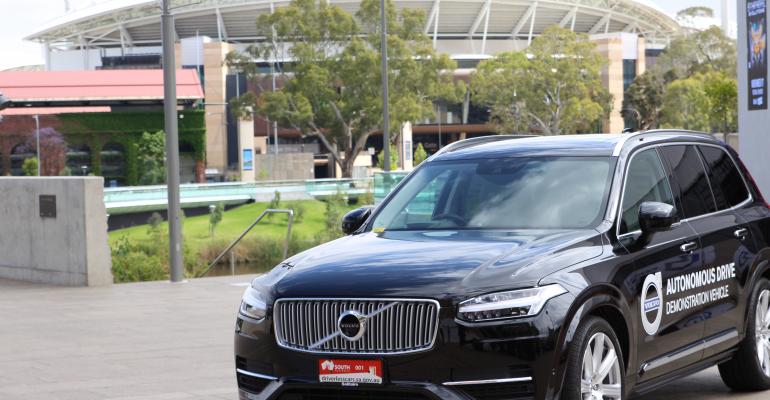Cars equipped with autonomous-drive features could be on Australian roads by 2020 if the states and territories amend their traffic laws to allow the rapidly developing technology, says Kevin McCann, Australian managing director-Volvo Car.
He commented as government ministers and media from across Australia were among a handful of people to be the first to travel in a driverless Volvo XC90. The luxury SUV demonstrated automatic lane keeping, adaptive cruise control and active queue assist under the supervision of a Volvo operator.
The demonstrations, the first in the Southern Hemisphere, were conducted on a closed, controlled section of Adelaide’s Southern Expressway.
The vehicle traveled at speeds of up to 44 mph (70 km/h) and the addition of a standard vehicle to simulate traffic showed how the driverless-vehicle technology interacts with other road users and adapts to changing conditions.
“Autonomous-drive technology is here now,” McCann says in a statement. “There will be roads where the technology is applicable and the autonomous features of the car can work effectively.
“I am confident that within three or four years we can have cars with autonomous-drive features being driven on prescribed roads if state governments change their laws to accommodate them.”
Current legal restrictions require that a driver be fully in control of a vehicle at all times.
The driverless XC90 can sense what is going on around it in traffic, and react accordingly. It also can interact with other cars that do not have autonomous-drive technology.
“Autonomous-drive technologies actually make driving safer by reducing the number of decisions the driver has to make,” McCann says.
The XC90 trial was held in conjunction with ARRB Group, formerly the Australian Roads Research Board, and the South Australian government.
ARRB Group Managing Director Gerard Waldron calls the trial a major turning point for the evolution of driverless-car technology in Australia. “This demonstration marks the first of a series of research and field trials nationally to identify and assess what needs to be done to make driverless cars appropriate in an Australian context,” he says.
South Australian Premier Jay Weatherill says driverless-car technology not only promises to improve safety and lower emissions, but also offer countless opportunities for the state’s economy.
“This industry has the potential to revolutionize transport in Australia,” Weatherill says. “We want to be at the forefront of this paradigm shift towards an industry which is anticipated to be worth more than $90 billion globally by 2030.”
Waldron says the Australian demonstration marks the beginning of a long and important process.
“With European researchers having a roadmap for the introduction of driverless vehicles by 2020, Australia needs to keep pace,” he says. “Legislation urgently needs to be amended, as it has been in South Australia.
“It’s also vitally important we educate Australian road users on the benefits driverless technology will bring to their lifestyles, to their safety and in relieving congestion issues on our roads.”





